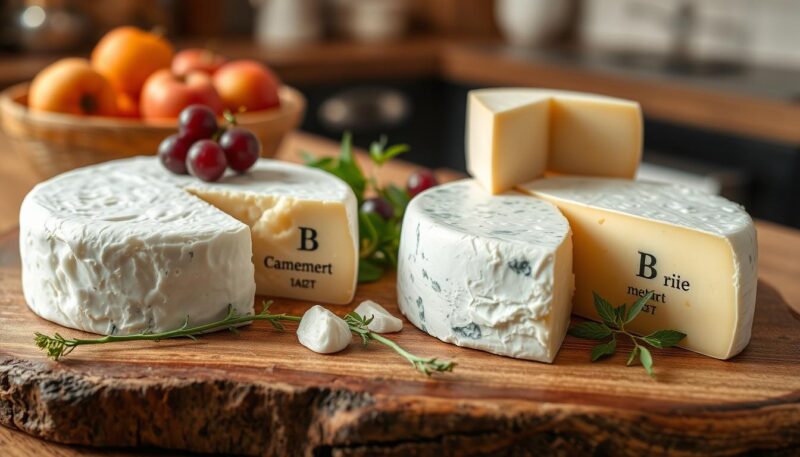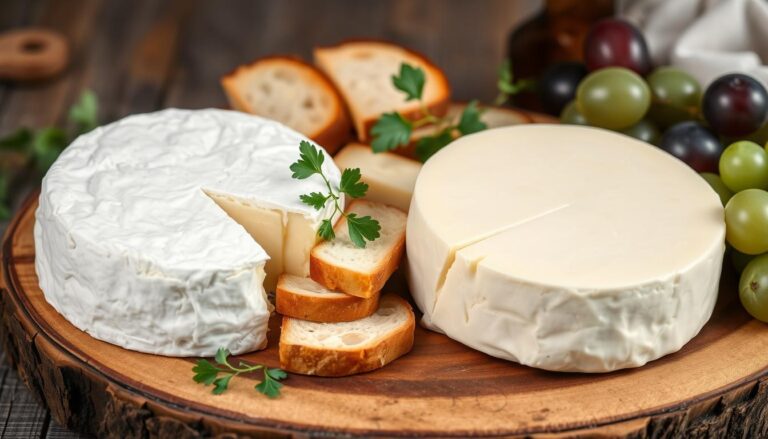As you embark on a journey to explore the world of French cheeses, you’ll likely come across two iconic varieties: Camembert and Brie. While they may seem similar at first glance, there’s a notable difference between Camembert and Brie. Understanding the distinction between these two cheeses will elevate your appreciation for their unique characteristics and production methods. The difference between Camembert and Brie lies in their size, flavor profiles, and manufacturing processes. Camembert vs Brie is a common debate among cheese enthusiasts, and knowing how Camembert differs from Brie will make you a connoisseur in no time.
Camembert cheese is typically made in a small format, usually no larger than eight ounces, whereas Brie de Meaux can weigh up to seven pounds. This significant size difference is just the beginning of the distinction between these two artisanal cheeses. As you delve deeper into the world of Camembert and Brie, you’ll discover the rich history and craftsmanship that sets them apart. The question of what sets Camembert apart from Brie is a fascinating one, and exploring the difference between Camembert and Brie will reveal the unique qualities of each cheese.
From the creamy texture to the earthy flavors, both Camembert and Brie offer a sensory experience like no other. As you explore the difference between these two iconic cheeses, you’ll gain a deeper appreciation for the art of cheese-making and the dedication that goes into crafting each wheel. Whether you’re a seasoned cheese enthusiast or just starting to explore the world of artisanal cheeses, understanding the distinction between Camembert and Brie will enhance your appreciation for these culinary delights. How Camembert differs from Brie is a story of tradition, craftsmanship, and a passion for creating exceptional cheeses.
The Rich Heritage of French Soft Cheeses
As you delve into the world of French soft cheeses, you’ll discover a rich tapestry of history and tradition. The camembert and brie comparison is a fascinating one, with both cheeses boasting a unique heritage. Brie, known as the “Queen of the soft French Cheeses,” has a centuries-old tradition, while Camembert was created in the 18th century by Marie Harel in Normandy.
Both cheeses have protected AOC status, ensuring they are produced using traditional methods in specific regions. This protection has helped preserve the unique characteristics of each cheese, making the brie cheese vs camembert debate a lively one among cheese enthusiasts. When exploring cheese varieties camembert and brie, it’s essential to consider the distinct flavors and textures that set them apart.
Some notable French soft cheeses include Brie de Meaux, Brie de Melun, and Camembert, each with its own unique story and production methods. For instance, Brie de Meaux gained AOC status in 1980, while Camembert was awarded the ‘Label Rouge’ in 1968 and gained AOC recognition in 1983. As you explore the world of French soft cheeses, you’ll discover a wealth of knowledge and appreciation for the artistry and tradition behind each wheel.
Whether you’re a fan of brie cheese vs camembert or simply looking to explore the world of cheese varieties camembert and brie, the rich heritage of French soft cheeses is sure to inspire and delight. With over 370 different cheeses produced in France, there’s no shortage of options to discover and savor.
Understanding the Difference Between Camembert and Brie
As you delve into the world of French soft cheeses, understanding camembert and brie becomes essential. The key to appreciating these iconic cheeses lies in recognizing their distinct characteristics, from camembert vs brie flavor profiles to brie cheese differences in texture and production methods. Camembert vs brie textures, for instance, are notably distinct, with Camembert boasting a firmer, more intense texture and Brie being milder and creamier.
A closer look at the production process reveals that Camembert is aged for a shorter period, typically around three to four weeks, which contributes to its slightly stronger flavor. In contrast, Brie is aged for five to ten weeks, resulting in a mild and buttery flavor. This difference in aging time also affects the calorie content, with Camembert containing around 299 calories per 100g and Brie containing approximately 334 calories per 100g.

When it comes to pairing these cheeses with other flavors, both Camembert and Brie pair well with sharp or sweet flavors such as grapes or figs and are commonly enjoyed with crackers, baguettes, and wine. The following table highlights some key differences between Camembert and Brie:
| Cheese | Aging Time | Calories per 100g | Milk Fat Content |
|---|---|---|---|
| Camembert | 3-4 weeks | 299 | 45% |
| Brie | 5-10 weeks | 334 | 60% |
By recognizing these differences, you’ll be well on your way to becoming a true connoisseur of French soft cheeses, capable of discerning the unique characteristics of Camembert and Brie and selecting the perfect cheese for any occasion.
Conclusion: Choosing Between These Iconic Cheeses
As you stand before the cheese counter, contemplating your choice between Brie and Camembert, remember that there is no wrong decision – only the opportunity to savor a piece of French culinary heritage. Whether you’re drawn to the creamy, subtle elegance of Brie or the bold, earthy notes of Camembert, your palate is in for a delightful experience.
Pair your cheese of choice with a selection of fruits, nuts, breads, and cured meats to create a harmonious flavor symphony. For Brie, consider pairing it with lighter white wines, while Camembert‘s robust profile complements bold red wines. Embrace the edible rinds of both cheeses, as they can enhance the overall taste experience.
Embark on a culinary adventure, experimenting with different pairings and exploring the nuances that make Brie and Camembert so beloved. Whether you’re hosting a gathering or simply indulging in a personal moment of gastronomic pleasure, let your newfound expertise guide you through the rich, creamy world of French soft cheeses. Your guests will be in awe of your sophisticated palate, and your taste buds will be forever grateful for this delightful journey.

